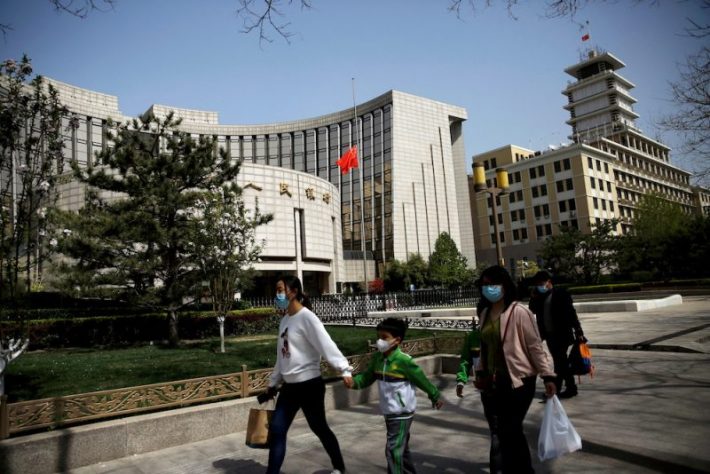New bank loans in China shot up to a record 4.9 trillion yuan ($720.2 billion) in January, according to the latest data in Beijing.
A rise was anticipated, as the People’s Bank of China (PBOC) wants to rev up the world’s second-biggest economy after tough Covid controls were lifted two months ago – but Monday’s figure was more than expected.
A strong rebound in credit demand will be essential for an economic revival this year after harsh pandemic controls and a crisis in the property sector dragged China’s growth down to 3% in 2022, one of its worst rates in nearly half a century.
January’s new loans more than tripled December’s tally and exceeded analysts’ expectations, according to data released by the central bank on Friday.
ALSO SEE:
China Claims US Flew High-Altitude Balloons Over its Airspace
Analysts polled by Reuters had predicted new yuan loans would jump to 4 trillion yuan in January, from 1.4 trillion yuan in December and above the previous monthly record of 3.98 trillion yuan in January 2022.
Chinese banks tend to issue more loans at the beginning of the year to gain higher-quality customers and win market share, but the size of the increase spurred hopes that business and consumer confidence is improving rapidly after the anti-Covid curbs were suddenly lifted in December.
“China’s credit data came in stronger than expected, suggesting that the credit support remains strong at the beginning of the year,” Zhou Hao, chief economist at Guotai Junan International, said in a note.
“Overall, this is a positive credit report, and is likely to help the economy to rebound significantly in the first quarter of 2023. The next focus for the markets will be property sales, which are highly correlated to bank credit.”
Analysts believe improved credit conditions, along with robust infrastructure spending and supportive policy measures, could boost economic growth to about 5% this year, even with a weaker global backdrop.
But they warn the recovery momentum could be uneven, requiring policy to remain supportive for some time.
Factory prices fell
Other data released on Friday showed China’s January factory gate prices fell more than expected, suggesting that manufacturers are not yet running at full speed even after the end of the zero-Covid policy, while a car industry association said vehicle sales slumped 35% from a year earlier.
“Banks were under pressure to gear up loan issuance from the fourth quarter last year under policy guidance to boost credit supply. But actual demand is weak,” said one person at a state-owned bank, who declined to be identified.
Manufacturing firms’ appetite for more credit remained soft since they took on so many loans last year, he added.
Household loans, mostly mortgages, rose to 257.2 billion yuan in January from 175.3 billion yuan in December, while corporate loans soared to 4.68 trillion yuan from 1.26 trillion yuan.
The divergence between corporate and household loans underlined a faster recovery in corporate credit while the high jobless rate weighed on household confidence, said Zhiwei Zhang, chief economist at Pinpoint Asset Management.
China’s new household deposits rose to 6.2 trillion yuan in January from 2.88 trillion yuan in December. Analysts are closely watching that figure for signs that shell-shocked consumers are spending again after a year of lockdowns and job losses battered sentiment.
Modest easing forecast
Other key credit gauges also showed encouraging gains.
Broad M2 money supply in January grew 12.6% from a year earlier – the fastest pace since April 2016 and above estimates of 11.6% forecast in the Reuters poll. It rose 11.8% in December.
Outstanding yuan loans grew 11.3% from a year earlier compared with 11.1% growth in December. Analysts had expected 11.0% growth.
The central bank has promised to make its policy “precise and forceful” this year to support the economy, keeping liquidity reasonably ample and lowering funding costs for businesses.
Analysts also expect the central bank to cut the benchmark lending rate – the one-year loan prime rate(LPR) – by another 5 basis points (bps) in the first quarter, and it is expected to offer more targeted support measures for sectors which are struggling the most.
Some analysts are also expecting more cuts in banks’ reserve ratios (RRR) this year after two reductions last year, the latest in December.
Year-on-year growth of outstanding total social financing, a broad measure of credit and liquidity in the economy, eased to 9.4% in January – the slowest pace since January 2017 – from 9.6% in December.
Total social financing includes off-balance sheet forms of financing that exist outside the conventional bank lending system, such as initial public offerings, loans from trust companies and bond sales.
In January, total social financing jumped to 5.98 trillion yuan from 1.31 trillion yuan in December. Analysts had expected 5.40 trillion yuan.
- Reuters with additional editing by Jim Pollard
ALSO SEE:
China Tightens Banks’ Reporting Rules to Classify Risks Better
Chinese Manufacturing Yet to Pick Up, Factory Prices Drop
US ‘Not The Only Target’ Of Chinese Spy Balloons, Says Blinken
























